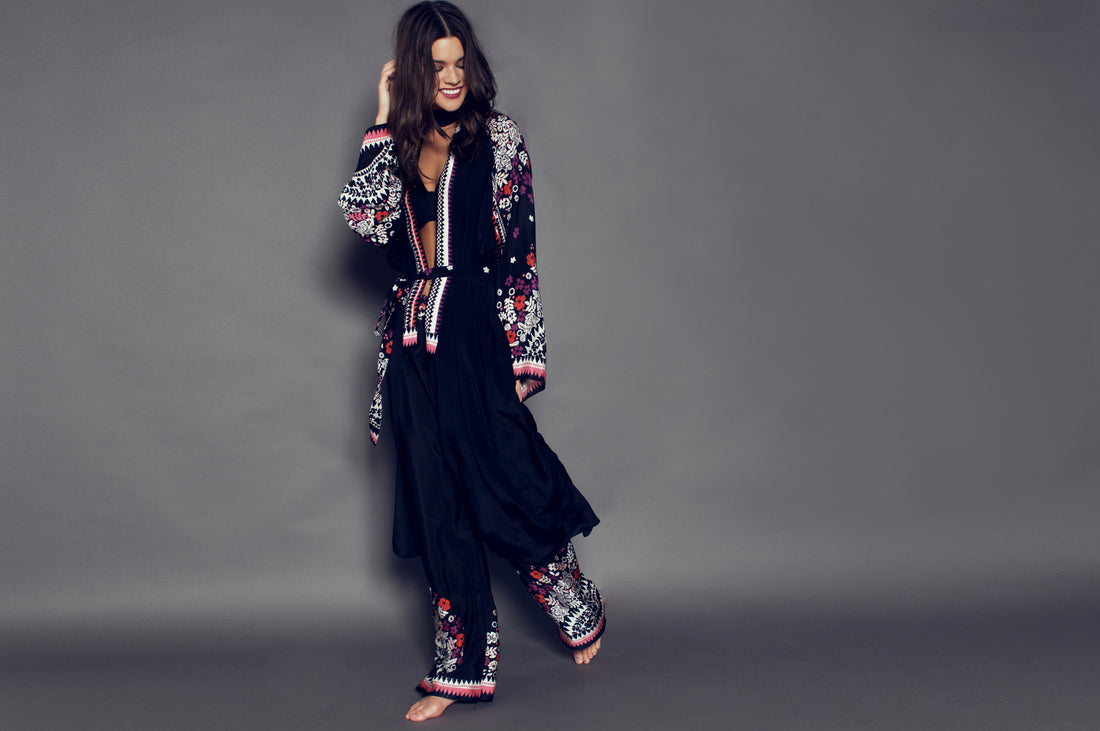
The Kimono. PATTERN FOCUS, CONSCIOUS CONSUMPTION.
Share
#KIMONO #ZEROWASTE #INNOVATIVEFASHION
Under my creative company 10 Holland Street I have been creating wearable engineered textile print designs since 2011, a concept developed whilst studying at the RCA with the support from InnovationRCA.
‘Innovation, where concept and craft collide’
Hand-drawn, large scale prints make up one part of my process but I have become equally passionate about turning my 2D designs into something wearable and 3 dimensional. I have created my own innovative minimised-waste production and construction method using digital print technology and I have always chosen to work predominantly with the silhouette of the kimono; A gender free, one size, fully inclusive item that is as relevant now as it throughout history.
‘Sustainable fashion’ often brings up ideas of design with a compromise however in order to be conscious with consumption, we need to buy less but buy better. I believe that design should ultimately be beautiful.
My print inspiration for the drawing is based around communicating a theme (often historic) or concept through pattern and is usually inspired by relevant cultural or social contexts. Continuing themes include Japanese graphic design in the 20th century and the work of ‘Ikko Tanaka’ (Please read my Selvedge Magazine feature on page 3 of images), and ‘East meets West’; Orientalism in Fashion in French Society in the 1900’s.
The company ethos lies with experimental ‘engineered’ textile compositions, vibrant prints, and detailed craftsmanship, creating delicate beauty mixed with the bold and brave. The BBC Culture Journalist Liza Foreman has called me ‘one of the designers taking the kimono into the future’ and The Financial Times has quoted the products as ''Kaftans and kimonos that capture the zeitgeist’’.
LOOKING BACK, LOOKING FORWARD. EAST MEETS WEST- FRENCH FASHION IN 20TH CENTURY
The kimono is an icon of Asian apparel, evocative of Japan and in my opinion beauty. Kimono makers improved their craft to such extent that it became an art form.
Through my love for this powerful but gentle garment I have come to build a company inspired by its shape and form. To wholeheartedly say I am inspired by Asian culture would be untrue however I use the kimono lay-plan and silhouette as a way of communicating by print design.
I have been philosophising about the impact of the appropriation of my print designs and have questioned as to whether I warrant the label of ‘kimono maker’ and my current commercial depth of research theory. My design values moving forward are to offer an appreciation and communication of this genre of clothing, and the artefacts from the period as basis of inspiration thus offering more integrity to its concept. An appealing aspect of the kimono shape is that of the large surface area which acts as a canvas to portray my drawings and engineered digital print designs. I believe these ideas push innovation boundaries of what can be and will be worn in the future with a deeper and more sophisticated link to the past in its approach. Combining a process of digitally printing the construction pattern pieces and including all production instructions, I have created in a form a kit where I cut the fabric out along a doted line and follow notches and seam allowances to turn my 2D flat prints into something 3 dimensional and most importantly wearable using less material, ink, water, and ultimately wastage.
Following formulas and processes has helped me think commercially about fashion and I am a self taught seamstress. Fashion designer Paul Poiret (1879-1944) views on the relationship between dress and art is affirmed in this quote, Dresses are like pictures, there is only one play where you can put a splash of colour, here or there is not goof enough, it has to be precisely placed’, I mention this as I take into consideration the cuffs, belts and collars to create engineered garments throughout my print.
My interest in Tim Walker was at the Story Teller exhibition at Somerset House in 2012/13, It was here I first felt the power and ambition of Walker’s work. ‘Extravagant in scale and ambition and instantly recognisable for their eye-opening originality, Walker’s photographs dazzle with life, colour and humour.’ I was intrigued by the focus of his exhibition which provided imaginative photography, but the camera, Walker claims, ‘is simply a box put between you and what you want to capture’. His themes of dressing up and displaying exuberance and fun is what I strive to portray in my practice and final pieces and his spontaneity and freedom is something admire and hold as further inspiration.
My ongoing sources of inspiration for the surface print is ‘East meets West’ in which I focus on Orientalism in French Society in the 20th Century, in particular Paul Poiret’s interpretation and his 1002nd night event. (1) . Western society were first educated on the Eastern countries when The East India Company brought back goods to Paris in the 17th Century.
Eastern porcelain, furniture and fabrics were seen as exotic objects and statuses of wealth. The trend for Orientalism would become a key inspiration for designers to come including Paul Poiret who I have found most profound in my research.
I have aspirations of finding that one piece in the archive that stimulates the main crux of research such as the ‘“La Perse” coat designed by Paul Poiret using a Raoul Dufy textile design, 1911. (Metropolitan Museum of Art).’ or inspiration taken from photographic research from the 1002nd night, an social event held by Poiret in 1911 to showcase his creations. I envision an interesting marriage between the kimonos adorned with vibrant, decorative and beautiful engineered prints inspired by eastern objects in the museum.
CURIOSITY, IMAGINATION AND EDUCATION
Excitement, adventure, humour and fun, I aim to create a fully immersive and exciting journey that delves into the mood and stories of this adventurous time through print design.
